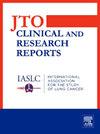Incidence and Outcomes of Brain Metastasis in Pleural Mesothelioma in the Era of Immunotherapy
IF 3.5
Q2 ONCOLOGY
引用次数: 0
Abstract
Introduction
Immunotherapy (IO) has reported efficacy in pleural mesothelioma (PM). Brain metastases (BMs) in PM are rare; thus, surveillance brain imaging is not included in the guidelines. We evaluated the incidence of BM by treatment type.
Methods
In this retrospective analysis, patients with PM treated at the University of Pennsylvania between January 1, 2015, and August 31, 2023, were included. Demographic and clinical data were extracted from the medical records. The treatment categories included chemotherapy, single-agent IO, and dual-agent IO. A two-tailed Z score was used to determine a difference in the proportion of BM. Overall survival (OS) was analyzed using the Kaplan-Meier method. Of those with BM, available brain tissue was further analyzed.
Results
In total, 251 patients were included; the median age of the participants was 73 years (range: 35–92 y), 79% were male individuals, 91% were white, and 73% had epithelioid histology. In the study, 102 (40.6%) were treated with chemotherapy, 100 (39.8%) with single-agent IO, and 49 (19.5%) with dual-agent IO. The median OS (mOS) was 21.6 months (95% confidence interval: 17.7–25.5) and did not differ between treatment groups (p = 0.774). A higher proportion of patients treated with IO developed BM than those treated with chemotherapy (6/149 [4%] versus 0/102 [0%]; Z score p = 0.04). The mOS from BM diagnosis was 95 days (range: 16–1025 d). The histomorphology of three patients with available brain tissue were similar to the primary site and reported substantial edema and hemorrhage.
Conclusions
In this retrospective study, clinically significant BM was most prevalent in those exposed to IO and not seen in those receiving chemotherapy despite similar mOS between the groups. Brain imaging should be considered before starting IO in patients with PM.
免疫治疗时代胸膜间皮瘤脑转移的发生率和预后
免疫疗法(IO)已被报道对胸膜间皮瘤(PM)有效。PM的脑转移(BMs)是罕见的;因此,监测脑成像不包括在指南中。我们根据治疗类型评估脑转移的发生率。方法回顾性分析2015年1月1日至2023年8月31日在宾夕法尼亚大学治疗的PM患者。从医疗记录中提取人口统计和临床数据。治疗类别包括化疗、单药IO和双药IO。采用双尾Z评分来确定BM比例的差异。采用Kaplan-Meier法分析总生存期(OS)。对于脑转移患者,进一步分析可用脑组织。结果共纳入251例患者;参与者的中位年龄为73岁(范围:35-92岁),79%为男性,91%为白人,73%为上皮样组织学。本研究中102例(40.6%)采用化疗,100例(39.8%)采用单药IO, 49例(19.5%)采用双药IO。中位OS (mOS)为21.6个月(95%可信区间:17.7-25.5),两组间无差异(p = 0.774)。接受IO治疗的患者发生脑转移的比例高于化疗患者(6/149[4%]对0/102 [0%]);Z分数p = 0.04)。BM诊断的最小生存期为95天(范围:16-1025天)。3例患者脑组织组织形态与原发部位相似,均有明显水肿和出血。结论在这项回顾性研究中,临床显著性脑转移在IO暴露组中最为普遍,而在化疗组中未见,尽管两组间mOS相似。PM患者在开始IO前应考虑脑成像。
本文章由计算机程序翻译,如有差异,请以英文原文为准。
求助全文
约1分钟内获得全文
求助全文
来源期刊

JTO Clinical and Research Reports
Medicine-Oncology
CiteScore
4.20
自引率
0.00%
发文量
145
审稿时长
19 weeks
 求助内容:
求助内容: 应助结果提醒方式:
应助结果提醒方式:


